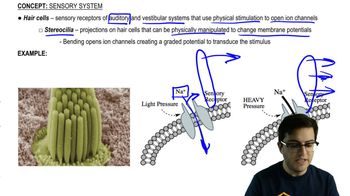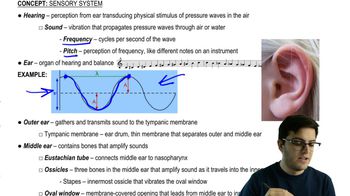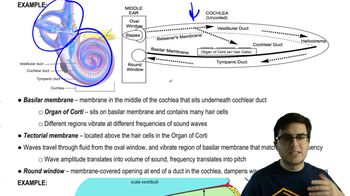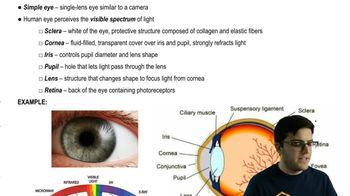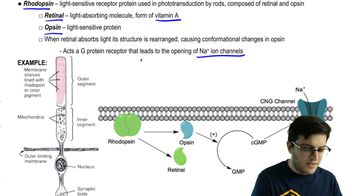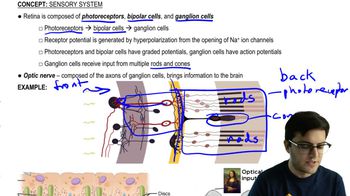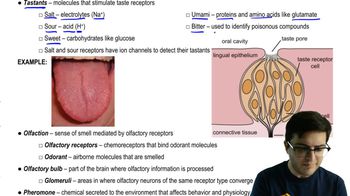Table of contents
- 1. Introduction to Biology2h 42m
- 2. Chemistry3h 40m
- 3. Water1h 26m
- 4. Biomolecules2h 23m
- 5. Cell Components2h 26m
- 6. The Membrane2h 31m
- 7. Energy and Metabolism2h 0m
- 8. Respiration2h 40m
- 9. Photosynthesis2h 49m
- 10. Cell Signaling59m
- 11. Cell Division2h 47m
- 12. Meiosis2h 0m
- 13. Mendelian Genetics4h 44m
- Introduction to Mendel's Experiments7m
- Genotype vs. Phenotype17m
- Punnett Squares13m
- Mendel's Experiments26m
- Mendel's Laws18m
- Monohybrid Crosses19m
- Test Crosses14m
- Dihybrid Crosses20m
- Punnett Square Probability26m
- Incomplete Dominance vs. Codominance20m
- Epistasis7m
- Non-Mendelian Genetics12m
- Pedigrees6m
- Autosomal Inheritance21m
- Sex-Linked Inheritance43m
- X-Inactivation9m
- 14. DNA Synthesis2h 27m
- 15. Gene Expression3h 20m
- 16. Regulation of Expression3h 31m
- Introduction to Regulation of Gene Expression13m
- Prokaryotic Gene Regulation via Operons27m
- The Lac Operon21m
- Glucose's Impact on Lac Operon25m
- The Trp Operon20m
- Review of the Lac Operon & Trp Operon11m
- Introduction to Eukaryotic Gene Regulation9m
- Eukaryotic Chromatin Modifications16m
- Eukaryotic Transcriptional Control22m
- Eukaryotic Post-Transcriptional Regulation28m
- Eukaryotic Post-Translational Regulation13m
- 17. Viruses37m
- 18. Biotechnology2h 58m
- 19. Genomics17m
- 20. Development1h 5m
- 21. Evolution3h 1m
- 22. Evolution of Populations3h 52m
- 23. Speciation1h 37m
- 24. History of Life on Earth2h 6m
- 25. Phylogeny2h 31m
- 26. Prokaryotes4h 59m
- 27. Protists1h 12m
- 28. Plants1h 22m
- 29. Fungi36m
- 30. Overview of Animals34m
- 31. Invertebrates1h 2m
- 32. Vertebrates50m
- 33. Plant Anatomy1h 3m
- 34. Vascular Plant Transport1h 2m
- 35. Soil37m
- 36. Plant Reproduction47m
- 37. Plant Sensation and Response1h 9m
- 38. Animal Form and Function1h 19m
- 39. Digestive System1h 10m
- 40. Circulatory System1h 57m
- 41. Immune System1h 12m
- 42. Osmoregulation and Excretion50m
- 43. Endocrine System1h 4m
- 44. Animal Reproduction1h 2m
- 45. Nervous System1h 55m
- 46. Sensory Systems46m
- 47. Muscle Systems23m
- 48. Ecology3h 11m
- Introduction to Ecology20m
- Biogeography14m
- Earth's Climate Patterns50m
- Introduction to Terrestrial Biomes10m
- Terrestrial Biomes: Near Equator13m
- Terrestrial Biomes: Temperate Regions10m
- Terrestrial Biomes: Northern Regions15m
- Introduction to Aquatic Biomes27m
- Freshwater Aquatic Biomes14m
- Marine Aquatic Biomes13m
- 49. Animal Behavior28m
- 50. Population Ecology3h 41m
- Introduction to Population Ecology28m
- Population Sampling Methods23m
- Life History12m
- Population Demography17m
- Factors Limiting Population Growth14m
- Introduction to Population Growth Models22m
- Linear Population Growth6m
- Exponential Population Growth29m
- Logistic Population Growth32m
- r/K Selection10m
- The Human Population22m
- 51. Community Ecology2h 46m
- Introduction to Community Ecology2m
- Introduction to Community Interactions9m
- Community Interactions: Competition (-/-)38m
- Community Interactions: Exploitation (+/-)23m
- Community Interactions: Mutualism (+/+) & Commensalism (+/0)9m
- Community Structure35m
- Community Dynamics26m
- Geographic Impact on Communities21m
- 52. Ecosystems2h 36m
- 53. Conservation Biology24m
46. Sensory Systems
Sensory System
Problem 4`
Textbook Question
Which sensory distinction is not encoded by a difference in neuron identity?
a. White and red
b. Red and green
c. Loud and faint
d. Salty and sweet
 Verified step by step guidance
Verified step by step guidance1
Understand that sensory distinctions can be encoded by different mechanisms, such as different types of neurons or different patterns of neuron activity.
Consider the options: colors (white, red, green) are typically distinguished by different types of photoreceptor cells in the retina, each sensitive to different wavelengths of light.
Taste (salty and sweet) is encoded by different types of taste receptor cells, each sensitive to different chemical compounds.
Sound (loud and faint) is not encoded by different types of neurons, but rather by the frequency and amplitude of the sound waves, which affect the rate of neuron firing.
Identify that the distinction between loud and faint sounds is based on the intensity of the stimulus rather than the identity of the neurons, making it different from the other options.
Conclude that the correct answer is the one where the distinction is not based on neuron identity, which is option c: loud and faint.
 Verified video answer for a similar problem:
Verified video answer for a similar problem:This video solution was recommended by our tutors as helpful for the problem above
Video duration:
41sPlay a video:
Was this helpful?
Key Concepts
Here are the essential concepts you must grasp in order to answer the question correctly.
Neuron Identity
Neuron identity refers to the specific characteristics and functions of neurons, which are determined by their genetic makeup and the types of neurotransmitters they produce. Different neurons are specialized to respond to specific stimuli, such as light, sound, or taste, allowing the brain to interpret various sensory inputs.
Recommended video:
Guided course

Neurons
Sensory Encoding
Sensory encoding is the process by which sensory information is translated into neural signals. This involves the activation of specific neurons that correspond to particular sensory modalities, such as color or sound intensity. The brain interprets these signals to differentiate between different sensory experiences.
Recommended video:
Guided course

Sensory Systems
Intensity vs. Quality in Sensory Perception
Intensity refers to the strength or magnitude of a sensory stimulus, while quality pertains to the type or nature of the stimulus, such as color or taste. Intensity differences, like loud and faint sounds, are often encoded by the frequency of neuron firing rather than distinct neuron types, unlike quality distinctions, which may involve different neuron identities.
Recommended video:
Guided course

Sensory Receptors
Related Videos
Related Practice




